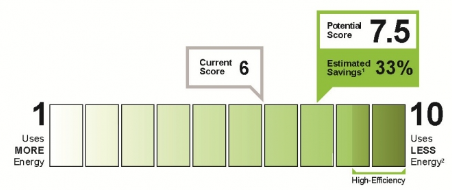
When we think of measuring building energy efficiency, we immediately think of the ENERGY STAR brand, which has been around since the early ‘90s. The new kid on the block is the Department of Energy’s Building Energy Asset Score. Today’s blog provides a quick overview of the Building Energy Asset Score, including a comparison with ENERGY STAR, in a convenient Q/A format.
Q: What is the DOE’s Building Energy Asset Score?
A: The U.S. Department of Energy’s Building Energy Asset Score (Asset Score) is a national standardized tool for assessing the physical and structural energy efficiency of commercial and multifamily residential buildings. The Asset Score generates a simple energy efficiency rating that enables comparison among buildings, and identifies opportunities to invest in energy efficiency upgrades. It is 100% free to use.
Q: What Building Types can be scored?
A: The DOE lists 16 building types that may be evaluated using the Asset Score:
| Office |
Library |
| Retail |
Lodging |
| Multifamily |
Medical office |
| Assisted living |
Parking garage |
| City hall |
Police station |
| Community center |
Post office |
| Courthouse |
Senior center |
| Educational (including K-12 schools) |
Warehouse (unrefrigerated) |
| House of Worship |
Mixed-Use (of the above types) |
NOTE: Single-family homes and attached homes can be scored using DOE’s Home Energy Score. Email homeenergyscore@ee.doe.gov for more information.
Q: How does the Asset Score work?
A: Buildings are evaluated by assessing the underlying energy assets that are somewhat independent from tenant usage patterns. These assets include:
- Building envelope (roof, walls, and windows)
- Lighting
- Hot water
- HVAC
These assets have a significant impact on how efficiently energy is used within a building regardless of the behavior of its occupants.
The DOE Building Energy Asset Score assesses the energy efficiency of these assets and identifies opportunities for improvement. Using building information provided by the user, the tool runs a sophisticated whole-building energy simulation and generates an Energy Asset Score Report that includes the following actionable information:
- A score ranging from 1 to 10 based on the energy efficiency of the building envelope and the mechanical, electrical, and service hot water systems
- An energy efficiency assessment of the building’s individual systems
- Total estimated building energy usage and energy use by end use (lighting, heating, cooling, service hot water) under standard operating conditions
- Opportunities to upgrade building efficiency, and a “potential” energy efficiency score based on identified upgrades
Q: What kind of preliminary information is required?
A: The DOE has a lite version and a full version of their Asset Score Data Collection Forms. The full version provides the most complete analysis. The forms request detailed information on the building physical attributes, equipment, and construction.
Q: What’s the difference between the ENERGY STAR score and the Building Energy Asset Score?
A: These are related and complimentary metrics. Think of them as measuring the “Actual” vs. “Potential” energy performance of your building(s).
The ENERGY STAR score is a 100-point scale that is a “whole building” measure of building energy efficiency based on the general building type and the actual energy use as revealed by the utility billing history. The system was created in 1992.
The Asset Score, by contrast, is a 10-point scale that does not incorporate current or historical energy use, but is based on the detailed building information provided, as well as known energy use patterns for similar structures and equipment. As noted below, the Asset Score deliverables include customized guidelines for enhancing the energy efficiency potential for the building. Pilot testing of the Asset Score metric was completed in 2012-2013.
Q: What’s the value?
A: According to the DOE, the Asset Score is intended for use by a variety of stakeholders, including building owners, third-party property and facilities managers, energy services companies and consultants, utility program administrators, architects, building engineers, and state and local governments.
- Building owners and third-party management companies can use the Asset Score to guide energy improvements, demonstrate national sustainability leadership, and ensure the market recognizes their investments in building energy efficiency regardless of tenant behavioral impacts.
- Energy services companies, engineers and green building consultants can leverage the Asset Score to enhance their proprietary services and engage new customers, and integrate their tools seamlessly with the Asset Score through an application programming interface.
- State and local governments can identify energy cost-saving opportunities in their own portfolios and make that information transparent and accessible to taxpayers.
Utilities and utility program administrators can use Asset Score results to identify customers for energy efficiency rebates and help them achieve their energy efficiency targets more quickly and cost-effectively.
The DOE Asset Score is a fairly new measure, and the DOE has issued a general invitation for interested organizations to explore the new metric to determine its advantages for them. For more information, see http://energy.gov/eere/buildings/building-energy-asset-score.
{{cta(‘84247b64-49cf-4317-9cf6-5c0a1408f7b9’)}}
 Best-in-class portfolio-level energy and utility bill data management and reporting.
Best-in-class portfolio-level energy and utility bill data management and reporting.
 Real-time energy and sustainability analytics for high-performance, net-zero buildings.
Real-time energy and sustainability analytics for high-performance, net-zero buildings.
 A holistic view of financial-grade scope 1, 2, and 3 carbon emissions data across your entire business.
A holistic view of financial-grade scope 1, 2, and 3 carbon emissions data across your entire business.
 Energy and sustainability benchmarking compliance software designed for utilities.
Energy and sustainability benchmarking compliance software designed for utilities.



